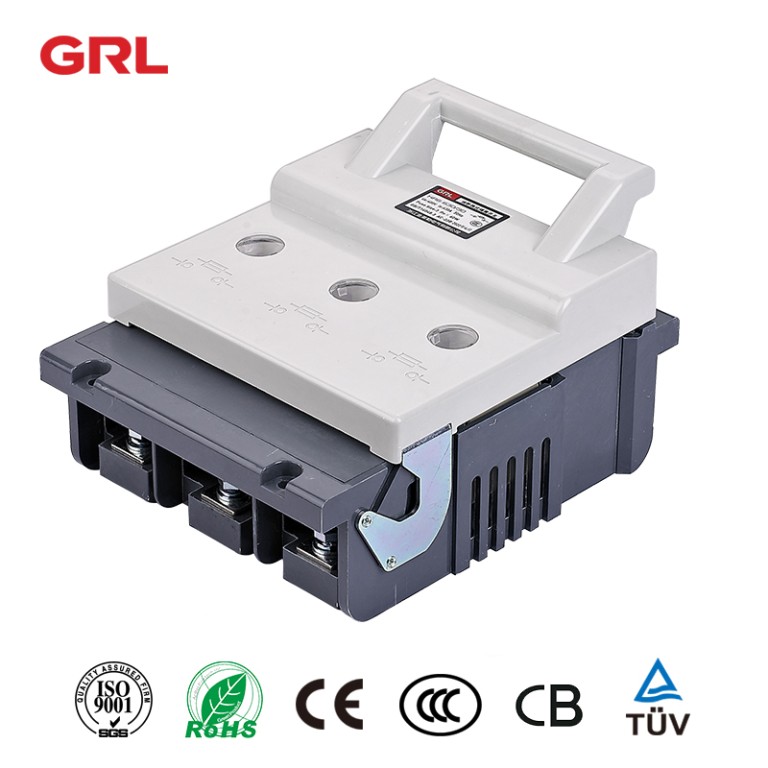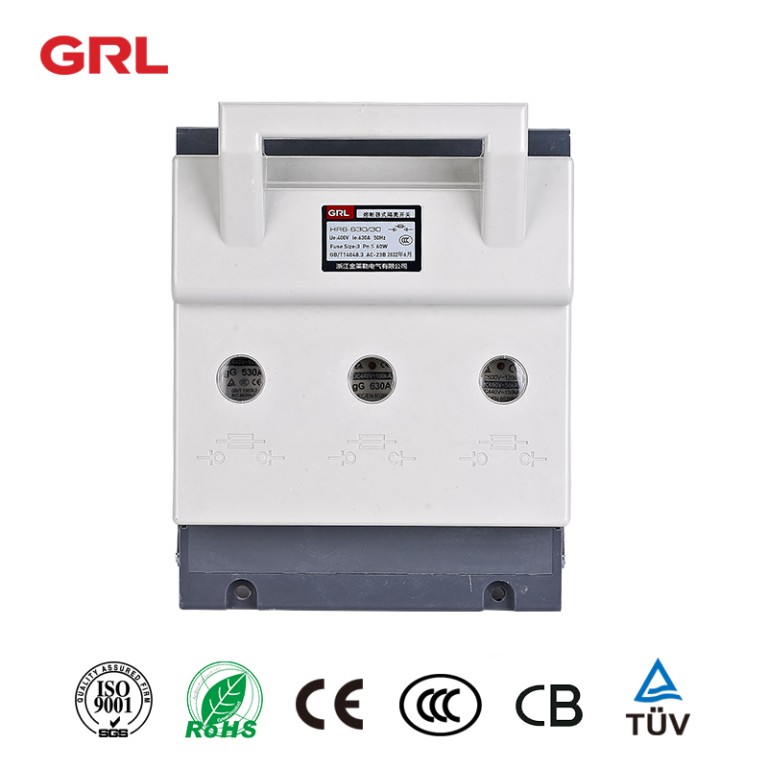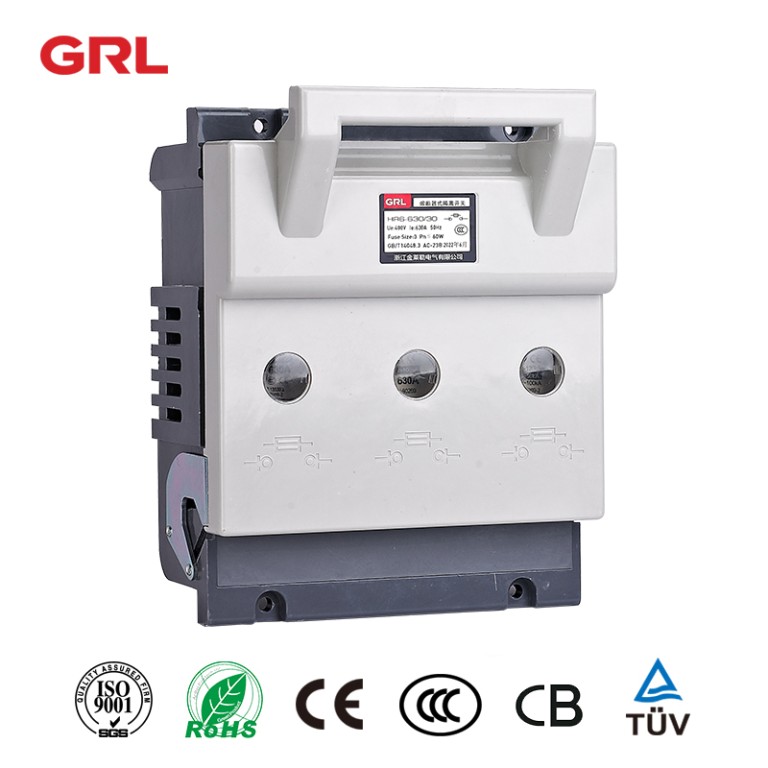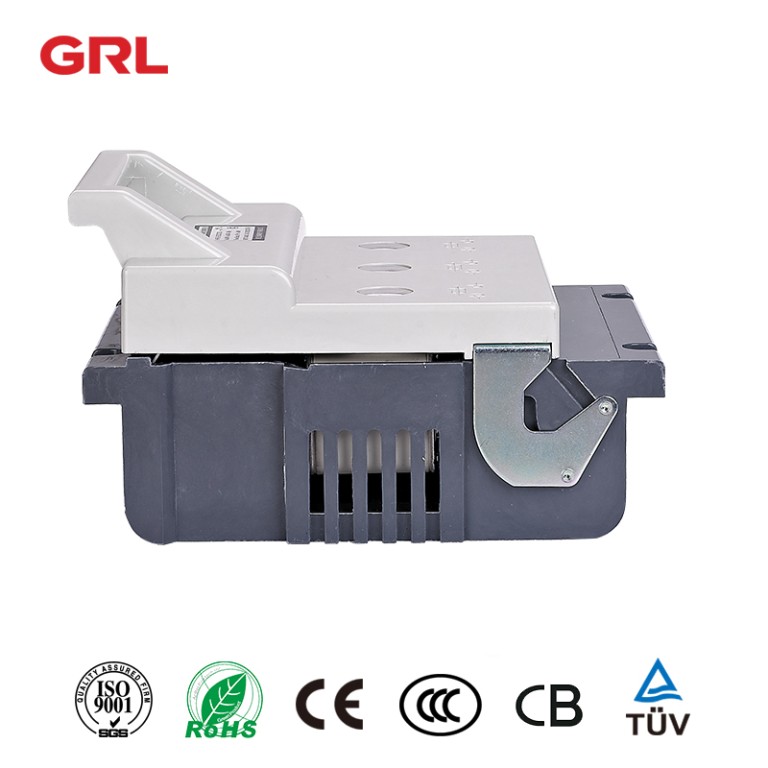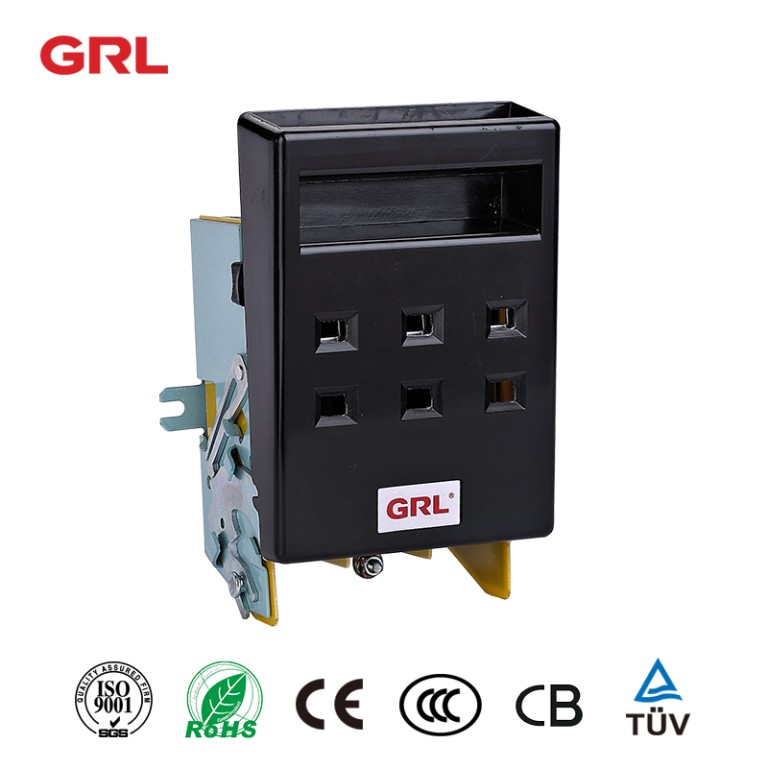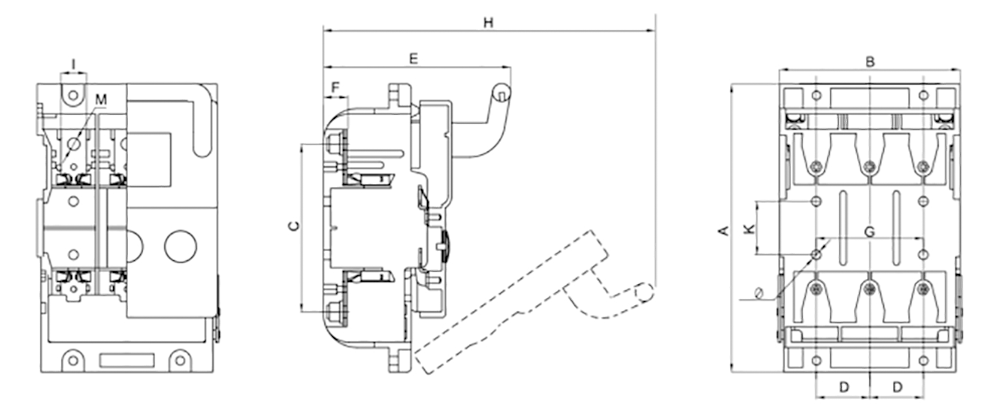Scope of application
HR6 series fuse disconnectors fuse Isolating switch (hereinafter referred to as switches) are mainly used in power distribution circuits and motor circuits with high short circuit current with rated voltage AC400/690V and agreed heating current up to 800A,
as power switches, disconnectors, emergency switches, and circuit protection, but generally not used to directly open and close single motor This product complies with IEC60947-3GBT14048.3 standard.
Structure characteristics
The fuse Isolating switch is composed of base, cover, arc extinguishing chamber and other parts, all of which are made of arc resistant plastic with full plastic structure.
The static contact is directly installed on the fuse Isolating switch base, so the arc extinguishing chamber is easy to disassemble and assemble.
Each arc extinguishing chamber has two parts: an inner chamber and an outer chamber. Multiple metal arc extinguishing grids are used to enhance the arc extinguishing ability and improve the contact life.
The NT type fuse link is installed inside the cover. The cover can be fan-shaped, rotated along the supporting elements.
It has a large electrical isolation distance to meet the requirements of the disconnector. The cover can be easily removed from the base, making it easy to install and replace the fuse link.
There are two sets of installation holes on the bottom seat, which can meet the installation requirements in various switch cabinets and on the panel.
On both sides of the switch, auxiliary contacts can be installed as required to send signals indicating the on-off state of the switch.
Normal operating conditions and installation conditions
The ambient air temperature shall not be higher than+40 ℃ and not lower than – 5 ℃. The altitude of the installation site shall not exceed 2000 m.
Humidity: when the maximum temperature is+40 ℃, the relative humidity of the air shall not exceed 50%. Higher relative humidity can be allowed at lower temperatures, such as 90% at 20 ℃.
For occasional condensation due to temperature changes, corresponding measures shall be taken. The pollution level of the surrounding environment is Level 3.
The fuse Isolating switch shall be installed in a place free from significant shaking, shock and vibration, rain and snow. At the same time, the installation site shall be free of explosive hazardous media, and the media shall be free of gas and dust that can corrode metal and damage insulation
Click to view grl DNH7-160 product>>
Main technical parameters
Matching relationship between switch and fuse link
| Agreed thermal power generation (A) | Model of flame breaker | Rated working voltage (v) | Melt current value (A) |
| 160 | NT00、RT16-00 | AC-23B 400 | 2,4,6,10,16,20,25,32,40,50,63,80,100,125,160 |
| 160 | NT00、RT16-00 | AC-22B 690 | 2,4,6,10,16,20,25,32,40,50,63,80,100 |
| 250 | NT1、RT16-1 | AC-23B 400 | 40,50,63,80,100,125,160,200,225,250 |
| 250 | NT1、RT16-1 | AC-22B 690 | 40,50,63,80,100,125,160,200 |
| 400 | NT2、RT16-2 | AC-23B 400 | 160,200,250,300,315,350,400 |
| 400 | NT2、RT16-2 | AC-22B 690 | – |
| 630 | NT3、RT16-3 | AC-23B 400 | 315,400,500,630 |
| 630 | NT3、RT16-3 | AC-22B 690 | 315,400,500 |
| 800 | NT3、RT16-3 | AC-23B 400 | 315,400,500,630,800 |
Switch technical parameters
| model | HR6-160 | HR6-250 | HR6-400 | HR6-630 | HR6-800 |
| Rated insulation voltage (V) | 1000 | 1000 | 1000 | 1000 | 1000 |
| Agreed heating current (A) | 160 | 250 | 400 | 630 | 800 |
| Rated working current (A) | 160 | 250 | 400 | 630 | 800 |
| Rated limiting short-circuit current (KA) | 50 | 50 | 50 | 50 | 50 |
| Size of matched fuse | 00 | 1 | 2 | 3 | 3 |
| class of pollution | 3 | 3 | 3 | 3 | 3 |
| Installation category | III | III | III | III | III |
Note: The rated voltage of auxiliary switch is AC 380V, the agreed heating current is 5A, the use category is AC-15, and the rated working power is 300VA
DNH1 Disconnect Switch Parameters
If we want to know what a fuse Isolating switch is, at first we have to look at other definitions:
Disconnect means to put (an electrical device) out of action by detaching it from a power supply.
A disconnect switch fuse Isolating switch device is a mechanical device which is meet the specified requirements for the isolating function in the open position of the circuit.
The purpose of a disconnect switch in an electric circuit is to power off all or discrete parts of a device for safety reasons by separating the device or part from each electrical energy source.
A disconnect switch fuse Isolating switch is a mechanical switching device capable of making, carrying and breaking current under normal circuit conditions, which may include specified operating overload conditions, or under specified abnormal circuit conditions (such as short circuits) for a specified period of time.
What is a Fused disconnect switch?
A disconnect switch fuse Isolating switch is a switching device that switches/isolates loads and distribution boards manually.
It is capable of making, carrying and breaking the specified rated current (including specified overload).
It protects backward electrical loads, safely disconnecting all electrodes and electrical components from the power supply under load.
In addition to the protection provided by the fuse, the Fused disconnect switch also has the characteristics of a load switch and an isolating switch.
It consists of three groups of switchblades and plastic bodies, each group of switchblades constitutes a double break for each phase. There is a gap reserved for bridging fuses in the centre of each set of blades.
The disadvantage of this arrangement is that when the switch is turned on to replace the fuse, the circuit connected to the fused disconnect switch may still have leakage current,
so electricians should use professional protective equipment such as insulating gloves, hard hats, etc. when they replacing the fuse.
The fuse type of disconnect switch performs the isolation function and also protects the circuit from overload currents.
Overload and short circuit protection for backward electrical equipment/loads are provided by inserting LV HRC fuse on the fused disconnect switch, usually, fuse size 000, 1 2 and 3, it is depending on the type of installation requirement.
HRC fuses have a high short-circuit breaking capacity. In addition, the opening time of the fuse-type isolating Disconnect switch after a short circuit is very short and fast. When the HRC fuse blows, a new fuse must be replaced on the fused disconnect switch.
The easiest and cheapest way to combine fusing and isolation functions is to use a fused disconnect switch. With these devices such as fuse bases, isolating switches and fused isolating switches, the fuse switch also functions as a switching element.
When removing the fuse holder, which also contains the fuse, a distinctly open isolation distance is existed, which can carry out safe maintenance work. A blown fuse can be easily removed and replaced.
Fused electric disconnect switch should only be operated practically by a trained and qualified electrician, and in accordance with the electric operating specifications, the electrician should be wearing protective clothing.
Because fused disconnect switches have a limited switching voltage and current capacity, they are therefore particularly suitable for applications where the switching function is only occasionally required.
Advantages of Fused disconnect switch
The benefits of Fuse types of disconnect switch are:
With isolation function.
It can withstand high short-time withstand circuits.
Open and close disconnect switch manually or automatically.
It can be switched to high current.
switch under load.
It is available in 2, 3, 4 pole versions.
It allows checking the work status of the fuse through the transparent cover.
How to choose a fused disconnect switch?
The fused disconnect switch is manufactured and to be used as conductor elements (link), the blade contact fuses. The selection of the type of fuse disconnector is directly related to the size of the fuse selected.
Therefore, first, a fuse housing (NH000 up to NH3) must be selected according to the incoming current to define which fuse-switch-disconnector will be used.
Second, you must check whether the fused disconnect switch is capable of carrying the circuit’s rated current or not. The rated current of the load must be less than or equal to the maximum current of the fused disconnect switch. The current rating of the fuse may be higher than the fused disconnect switch due to fuse size standards requirements.
Fused disconnect switch accessories:
There are many accessories that can be mounted on fuse switch disconnectors such as:
- Mechanical fuse monitoring
- Electronic fuse monitoring
- Cable lug terminals
- 3-phase busbars
- Auxiliary contacts
- Terminal covers
- Padlocks and sealings
Fused disconnect switch applications
Machine switching (on/off) (HVAC, Crane, Pump, Conveyor, Industrial furnace, shield machine)
Power distribution
Low voltage switchboard or feeder pillar
Motor control centres (Isolating and protecting motor starters)
Security applications
Power plants
UPS and telecom applications
Solar off-grid and on-grid applications
Fused disconnect switch circuit diagram
leave your question
GRL Electric Co., Ltd. is one of the leading companies in the Middle And High End market of low-voltage electric in China

